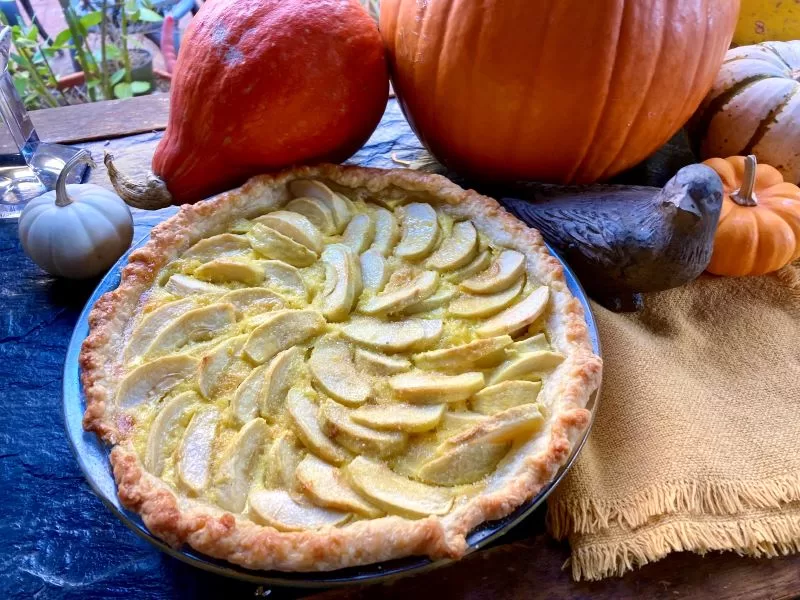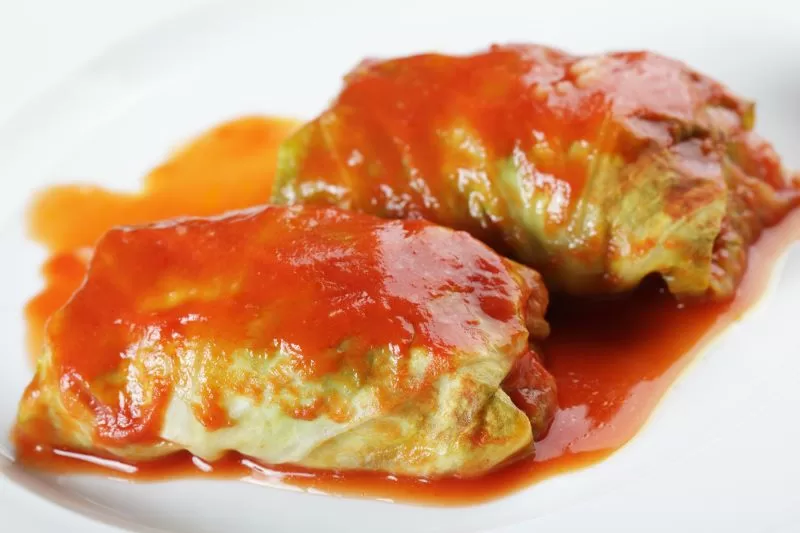Apfelwähe Swiss Apple Tart from Suzanne Guldimann

My father grew up in orchard country in Canton Aargau, in the German-speaking part of Switzerland. Apples are an important part of fall tradition there, and have become part of my family’s holiday traditions. I’m making Apfelwähe—Swiss apple custard tart—in memory of him this holiday season.
Apfelwähe is a Swiss cousin of Pennsylvania Dutch apple pie, but that’s not surprising. Swiss Protestants, including Mennonites and Amish, were among the immigrants who answered William Penn’s open invitation to settle in a place that offered religious freedom. Recipes like apple pie with custard traveled across the Atlantic with this wave of American immigrants in the late seventeenth and early eighteenth century, but my father brought our family recipe with him when he came to America in the 1950s.
I’m making two versions of Apfelwähe this year. The traditional tart, baked with a rich custard topping, and a vegan version that simply omits the custard and focuses on the flavor of the apples.
Apfelwähe has traveled a long way to become part of my family’s holiday traditions, and it reminds me of someone I loved very much who is with us on this day in spirit. Thank you for sharing this recipe dad!
Pastry
1 1/4 cup flour, plus more to roll the dough if it turns out too sticky
1/2 cup butter (or vegan butter), frozen
1/4-1/3 cup ice water
1-2 tablespoons sugar
1/4 teaspoon salt
Filling
6-8 tart apples—like granny smith
1/2 cup sugar, plus 2 tablespoons
1/2 cup cream (omit for vegan version)
2 eggs (omit for vegan version)
The juice and zest of one large lemon
1/3 cup ground blanched almonds (can be omitted)
1/4 cup apple juice or apple brandy
A pinch of salt
A dash of kirsch
1/4 tsp Almond extract (or vanilla) and fresh ground nutmeg
Mix the dry ingredients for the pastry together in a large bowl, adding sugar to taste. Tradition calls for a sweet pastry crust, but less sugar works, too. Grate the frozen butter using a box grater, and mix it in with a pastry cutter or a spatula—keeping the butter as cold as possible is the easiest way to ensure a flaky crust.
Slowly add ice water, a little at a time. Mix by hand until the dough forms and can be rolled into a smooth ball. Dryer weather often means a little more water will be needed, but the dough shouldn’t be too sticky. Don’t overwork it. Refrigerate the dough for at least two hours. Roll out on a floured board or between sheets of parchment paper and press into a greased tart pan or pie pan. Prick the bottom of the crust with a fork. For a tart pan, cut the edges of the crust with a sharp knife. For a pie pan, crimp the edges of the pastry.
Sprinkle the crust with almonds and two tablespoons of sugar.
Peel, core, and slice apples into thin slices. Add lemon juice and zest and steam in a saucepan with the apple juice or apple brandy for about five minutes—the goal is to gently start the cooking process, so the slices aren’t hard but keep their shape. Cool, then arrange the apples neatly in an overlapping spiral on the crust, in one or two layers, sprinkling half of the remaining sugar on top.
Bake for 10 minutes at 425 F in a preheated oven. While the first phase of baking takes place, prepare the custard.
Whisk the eggs and remaining sugar into the cream until smooth. Add almond extract to taste. Almond is the stronger flavor. Carefully remove the tart from the oven and pour the custard over the apples.
Add a dusting of fresh-ground nutmeg, and a sprinkle of kirsch if desired, and return to the oven. Bake at 350 degrees for 30 minutes, or until the crust is golden, the custard is set and the apples are cooked.
Let the tart cool a little before serving. Serve warm or cold.
Vegan version
Use a good quality vegan butter. Omit the custard and the pre-baking instructions. Instead, dust the apples with the cornstarch after steaming them and stir to mix, before arranging them on the pastry and sprinkling on the sugar. Just like the custard, the cornstarch will bind the apples together and keep them from being watery. Add nutmeg and kirsch and bake at 350 for 40 minutes, or until the crust is golden, the apples are cooked, and the liquid has thickened. It’s not traditional, but I find that the ground almonds work better on top of this version, instead of underneath. Cool before eating. Serve warm or cold.
Halupkies—Stuffed Cabbage from Jill Cotu

Growing up in suburban Detroit, I was fortunate enough to be exposed to many different cultures and traditions. Our neighborhood was a healthy mix of immigrants, predominantly Polish and Italian. My grandmother, of Sicilian ancestry, always brought dishes from her homeland to any table she was invited to. Inevitably, someone would ask her for her secret. The trading of recipe cards began, and that is how my grandmother received instructions on making the Polish (and Czech) dish called halupkies. It was thereafter ever-present at our family gatherings. Whether it was Christmas or even Thanksgiving, no meal was complete without these tasty stuffed cabbages. I have modified the original version to omit beef and include turkey instead.
You can thank me because I have also omitted grandma‘s Campbell’s condensed tomato soup, and swapped it for marinara sauce, which frankly is much more Italian. Serves 6-8
Ingredients
2 large heads of cabbage
2 pounds ground turkey
1 cup celery, chopped
3 medium onions, chopped
1-2 jars – or homemade – marinara
One clove, garlic, minced
Two eggs, or substitute flax eggs
2 cups white long grain rice
Butter
Crushed dried celery leaves
Salt (about 2 teaspoons) & pepper
Directions
Core cabbage and separate leaves. Parboil until pliable; cool. Important: shave the spine of each leaf to make for easier rolling.
Preheat your oven to 350 degrees.
Cook rice; meanwhile, sauté celery and onions in butter until glistening.
To the meat add the following:
Cooked rice, cooked celery and onions, salt and pepper, minced garlic, eggs, celery leaves. Mix well.
Fill cabbage leaves and roll up, tucking in the sides as you go like a burrito. Put halupkies in a casserole dish, and cover with marinara sauce. Season with more garlic, if desired. You want to have enough sauce to almost cover the cabbage rolls. Finally, cover the casserole dish with foil, and cook in the oven for approximately 1 1/2 to 2 hours.
Cook’s note: it is traditional to serve these with white vinegar as a condiment.




